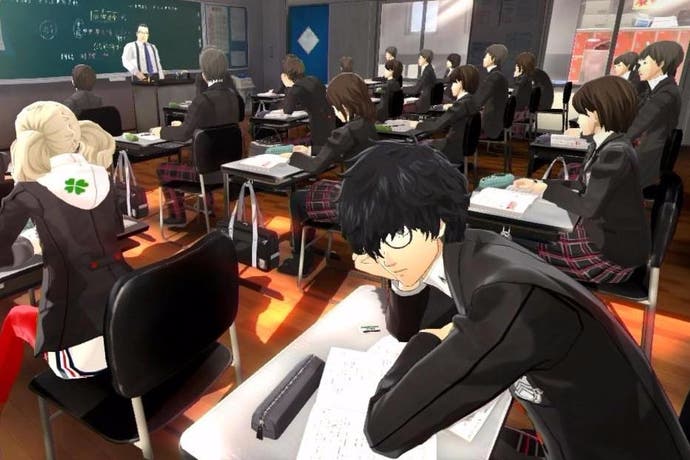Persona 5 Tipps: Schule - Alle Antworten der Lehrerfragen und Klassenarbeiten
So werdet ihr zum Musterschüler und steigert euren Wissenswert.
Durch das gesamte Schuljahr von Persona 5 hinweg wird euer Spielercharakter immer mal wieder vom seinen Lehrern zu gewissen Themen der Allgemeinbildung, manchmal aber auch japanischer Geschichte und Kultur befragt. Regelmäßig wird das erlangte Wissen dann auch in Prüfungsphasen samt Klassenarbeiten abgefragt.
Das passiert immer in Multiple-Choice-Form. Richtige Antworten in einzelnen Fragen geben euch jedes Mal einen Punkt in eurem Knowledge-Wert ("Wissen"), gutes Abschneiden in Klassenarbeiten kann aber auch andere Werte steigern. Und diese ermöglichen immer mal wieder neue Interaktionen mit anderen Charakteren. So könnt ihr zum Beispiel nur mit Makoto auf Dates gehen, wenn euer Wissen-Wert eine gewisse Schwelle überschreitet. Für Ann braucht ihr hingegen Güte ("Kindness").
Deshalb lohnt es sich, in der Schule "gut aufzupassen" und sich meisten der gewissermaßen hergeschenkten Wissen-Punkte mit richtigen Antworten unter den Nagel zu reißen, denn bedenkt: Ihr könnt euer Wissen zwar auch anders steigern, beispielsweise, indem ihr abends in eurem Zuhause ein Buch lest, aber in der Schule sitzt euer Charakter so oder so - ihr verbraucht also keine eurer begrenzten Aktionen für diesen Tag.
Kommen wir also zu den Fragen - einige davon sind ziemlich einfach und Gegenstand weit verbreiteten Allgemeinwissens. Manches jedoch stellt selbst den härtesten Anime-Fan auf eine ordentliche Probe. Um euch das Wälzen umfassender Wikipediaeinträge nach dem einen Fitzelchen Information zu ersparen, haben wir für euch eine übersichtliche Liste aller richtigen Schul-Antworten und und Prüfungsfragen angefertigt - natürlich nach Datum geordnet, damit ihr sie leichter findet.
Persona 5 School Exam Answers
12. April:
A soul is composed of appetite, spirit, and what else? Logic.
19. April:
Is the line extending from A connected to B or C? Which is it? C. (Careful! It's connected to line C, which is question option B.)
23. April:
What event did Emperor Nero add to the Olympics so he could participate? Singing.
25. April:
What's the common usage of kakushinhan again, regarding an action you take? Knowing your actions are wrong.
But the real kakushinhan is the opposite, right? So the opposite means... Conviction that you're right.
30. April:
First off, the "wunder" part probably means... Wonder.
Next, the "kind" part. That's probably... Child.
So a "wunderkind" would be... A prodigy.
7. Mai:
What do people generally call a woman who has a charm that sometimes leads men to their doom? A femme fatale.
10. Mai:
Who do you think is the origin of the term "magistrate's patronage"? Minamoto no Yoshitsune.

Prüfungen vom 11. bis zum 13. Mai:
- Although the line connects A to C it looks like it leads to B instead. What is this phenomenon called? An optical illusion.
- If how they're seeing things is different, it probably has to do with this sort of information... Visual information.
- What takes the visual information from your eyes and processes it is the, uh... Brain.
- The brain processes visual information. So, the reason why people see things differently is... They have different cognitions.
- Which of the following expressions came form the name of the position that Minamoto no Yoshitsune held? Magistrate's patronage.
- What is the origin of the English word "talent"? The name of a sum of currency.
- What did the Greek philosopher Socrates say that evil is born from? Ignorance.
- What's the least number of colors needed to paint Japan so no two adjacent areas are the same color? Four.
16. Mai:
Do you know who created the piece which sold for the highest price back in the 20th century? Van Gogh.
21. Mai:
What is the name of this ratio that Japanese architects and artists have liked using? The silver ratio.
23. Mai:
Well, your number's up. The root words of synesthesia are "syn" and "aisthesis". What do they mean? "Together" and "senses".
26. Mai:
What was the name of the other famous novel that Sherlock Holmes appeared in? "Arsene Lupin, Gentleman Burglar."
30. Mai:
Who was the pirate who said that he hid his treasure in a certain place just before he was executed? William Kidd.
4. Juni:
The original blazers were named that thanks to a certain quality they had. Any idea what it was? They were brightly colored.
7. Juni:
What are red king crabs most biologically related to? Hermit crabs.
8. Juni:
With the advent of the color TV, something else started appearing in color. Do you know what it is? Dreams.
11. Juni:
Can you imagine how much gold has been excavated by humanity over the course of history? Three Olympic-sized pools.
13. Juni:
Paper money is issued by the Bank of Japan, but who issues the coins? The government.
15. Juni:
What would happen if you keep washing your hair with water that's contaminated with metal? It'll change color.
23. Juni:
Who is this woman, drawn as the High Priestess in most tarot decks? Pope Joan.
27. Juni:
In English, what does the term "cat-and-dog weather" refer to? Heavy rain.
29. Juni:
This character is the cursive form of a specific kanji. Do you know which one it is? Gold.
1. Juli:
...But do you know what Chinese dish Zhuge Liang is credited for inventing? Baozi.
4. Juli:
Do you know the reason why July and August both have thirty-one days? Someone pretentious said so.
7. Juli:
What's the traditional food of Tanabata? Soumen.
8. Juli:
What's a common trait of almost all shaved-ice syrups on the market? They have the same flavor.
9. Juli:
What is the sum of angles a through e? 180 degrees.
11. Juli:
What is the name of the light-producing substance in fireflies? Luciferin.
12. Juli:
What was the name of the gentleman thief whose family was boiled alive during the Sengoku period? Ishikawa Goemon.
Prüfungen vom 13. bis 15. Juli:
- Which of these phrases has its origins in this shogi piece? Nouveau riche.
- Goemon was popular because he wasn't just a thief, he was a... Gentleman thief.
- And the person in power who had it in for Goemon was... Toyotomi Hideyoshi.
- And, Gomeon's death after he got captured by Hideyoshi is famous too... He was boiled alive.
- Which of the following statements are true of this organism? It's not related to crabs.
- What is said to be the reason why people began dreaming in color? Television.
- Which of these was made using the silver ratio? B4-size paper.
- Define "syn" and "aisthesis," the Greek root words of "synesthesia." "Together" and "senses."
Das ist noch längst nicht alles. Wir werden diese Liste in Kürze um die restlichen Fragen ergänzen. Bis dahin aber solltet ihr aber in etwa gut 50 Stunden zu spielen haben. Versucht, im harten Tokyoter Schulalltag nicht unter die Räder zu kommen.
Persona 5 ist ein fantastisches JRPG geworden - nicht, dass jemand etwas anderes erwartet hätte. In Sachen Stil und in seinem eigenwilligen Weltendesign steht es wie der dritte und vierte Teil mal wieder allein auf weiter Flur. Nichts ist wirklich vergleichbar - außer die eigenen Vorgänger. Die fand ich zwar zu ihrem jeweiligen Erscheinen stärker als nun den fünften Teil, aber das schmälert die Freude beim Spielen nicht substanziell.
Wer mehr zum Spiel wissen will, liest sich meinen Persona 5 Test durch. Das einzige, was man ihm vorhalten kann, ist dass die Geschichte nicht so unmittelbar packend ist wie im Vorgänger und es ein wenig zu lange dauert, bis sie wirklich in Fahrt kommt. Resultat: Bevor es wirklich genial wird, hat man schon 60 oder mehr Stunden auf dem Buckel. Verdirbt das Spiel aber nicht, wenn es so stylische Stunden sind wie hier.







